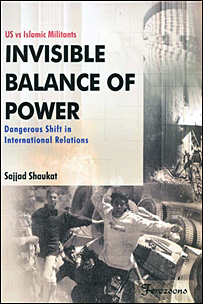“Invisible Balance of Power”. The Phenomenon of Terrorism, The “War on Terrorism”
A Review of Sajjad Shaukat's Book, Invisible Balance of Power

The world underwent a seismic change on September 11th, 2001 when the biggest, most blatant false flag terror even yet seen took place–the attack on the World Trade Centre in NYC and the Pentagon in Washington, DC. The official narrative blamed Osama Bin Laden and his Al-Qaeda Islamic terrorist group, a complete fabrication that has had far-reaching consequences.
The creation of the Islamic terrorist bogeyman began long before 9-11, the stereotypical fanatic menacingly waving AK47s and RPGs while screaming incoherently about Allah has been a mass media meme for decades–the 1985 Hollywood blockbuster Back To The Future featured a gang of Libyan terrorists, a decade later the James Cameron-Arnold Schwarzenegger movie True Lies had a plot revolving around Islamic terrorists and stolen nuclear weapons.
Clearly, powerful, shadowy figures in the West have sought to inculcate the minds of the public with the notion that Islamic terror was the new threat to peace and prosperity, to the Western, capitalistic way of life. They have used the mass media to drive this train of thought and sadly, they have been all too successful. A string of further false flag terror events blamed on Islamic fanatics has played out in countries such as Great Britain, France and Germany, the Western public has been sold on the idea that Islamic fundamentalists are a clear and present danger.
It is impossible to gain any meaningful insight into the true nature of these events and the forces driving them from the Western media, both the mainstream and ‘alternative’ forms have been utterly corrupted and co-opted. However, there are still those who seek to subvert the Western narrative and publish the truth about the geopolitics and Machiavellian machinations behind the events of the post 9-11 world.
One such figure is Pakistani author Sajjad Shaukat, in his book, Invisible Balance of Power, first published in 2005 and now republished fourth time in a revised edition, Shaukat examines the phenomena of terrorism and explains how there are both state and non-state actors behind the scenes. An example of the former would be the United States, of the latter, Al-Qaeda is the prime example. The book is packed with solid research and delves far deeper into this murky world than any Western author dares tread.
Shaukat is remarkably even-handed, his analyses notably free of prejudice as he compares and contrasts the tactics and techniques employed by both sides in the so-called ‘War On Terror’. The book contains detailed analysis of Al-Qaeda’s methods–the beheadings, the targetted assassinations, the hostage taking, the suicide bombings and the ambush attacks using improvised explosive devices. However, it also covers the methods used by the United States and it’s allies–the CIA black site prisons and their torture cells, the drone strikes, the kidnappings, the use of private military companies and their mercenaries.
Through painstaking research and in-depth analysis, Shaukat makes a compelling case that both sides in the War On Terror have employed the most cruel and ruthless terroristic methods and are responsible for the deaths of countless innocent civilians, the great majority of them citizens of Islamic countries.
The author goes further by placing this insightful analysis of the “War On Terror” against the backdrop of the global financial, social and political situation and giving a prescient viewpoint on how international finance and politics have been and will continue to be influenced by the perpetual nature of the wars involving both sides of the “War on Terror”; how social and economic instability has been created. One might consider this viewpoint to be almost clairvoyant, given recent unrest in France by the Gilets Jaunes and the ongoing violence in Afghanistan, to name just two examples.
Besides, author’s future assessments such as failure of the power factor or role force by the US-led countries in this ‘different war’ against the non-sovereign entities, prolonged war on terror, entanglement of the US/NATO countries in Afghanistan, increase in the cost of war, internal crises inside America, loss of America’s leverage of bargaining even on the small countries, economic instability in the world, state terrorism, resulting into more terrorism by the non-state actors as noted in case of Indian-Israeli brutal tactics on the Kashmiris and Palestinians, war in Syria, promotion of sectarian divide in the Islamic countries on the basis of Shia and Sunni, rivalry between Saudi Arabia and Iran, war-like situation between Syria and Israel, between Iran and Israel, between India and Pakistan, rise of Russia and China-their collective efforts for moving the world to the multi-polar system etc. proved true.
Shaukat also presents the reader with a set of proposals for resolving this mess, including reconciliation of warring parties and reform of the UN to empower the less powerful, less developed nations, thus leaving the reader with a sense of hope that this global conflict can be resolved.
Even if you do not agree with all of his analyses, you will come away from reading this book armed with a far deeper and more realistic understanding of the post 9-11 world than you could ever hope to garner from consumption of the Western media and that makes it compelling reading for all those who wish to develop a greater, more accurate knowledge of this world we live in.
*
Note to readers: please click the share buttons above or below. Forward this article to your email lists. Crosspost on your blog site, internet forums. etc.
Ian Greenhalgh is a British photographer, writer and historian with a particular interest in military history and the real causes of conflicts. His studies in history and background in the media industry have given him a keen insight into the use of mass media as a creator of conflict in the modern world. His favored areas of study include state sponsored terrorism, media manufactured reality and the role of intelligence services in manipulation of populations and the perception of events.

